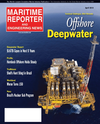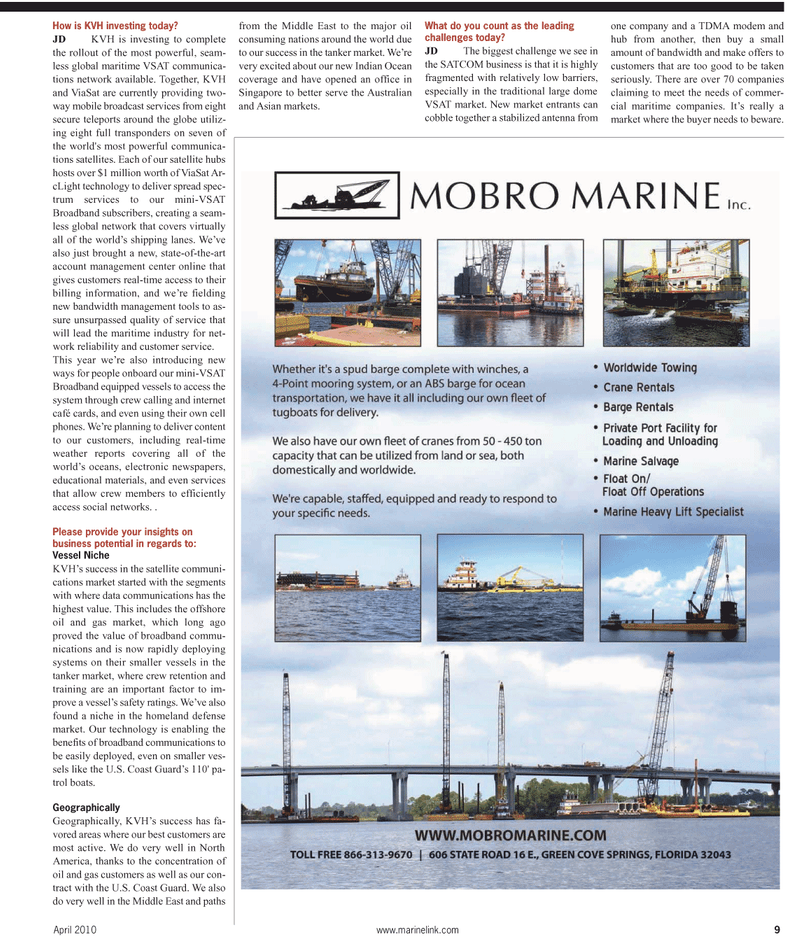
Page 9: of Maritime Reporter Magazine (April 2, 2010)
Read this page in Pdf, Flash or Html5 edition of April 2, 2010 Maritime Reporter Magazine
How is KVH investing today?
JD KVH is investing to complete the rollout of the most powerful, seam- less global maritime VSAT communica- tions network available. Together, KVH and ViaSat are currently providing two- way mobile broadcast services from eight secure teleports around the globe utiliz- ing eight full transponders on seven of the world's most powerful communica- tions satellites. Each of our satellite hubs hosts over $1 million worth of ViaSat Ar- cLight technology to deliver spread spec- trum services to our mini-VSAT
Broadband subscribers, creating a seam- less global network that covers virtually all of the world’s shipping lanes. We’ve also just brought a new, state-of-the-art account management center online that gives customers real-time access to their billing information, and we’re fielding new bandwidth management tools to as- sure unsurpassed quality of service that will lead the maritime industry for net- work reliability and customer service.
This year we’re also introducing new ways for people onboard our mini-VSAT
Broadband equipped vessels to access the system through crew calling and internet café cards, and even using their own cell phones. We’re planning to deliver content to our customers, including real-time weather reports covering all of the world’s oceans, electronic newspapers, educational materials, and even services that allow crew members to efficiently access social networks. .
Please provide your insights on business potential in regards to:
Vessel Niche
KVH’s success in the satellite communi- cations market started with the segments with where data communications has the highest value. This includes the offshore oil and gas market, which long ago proved the value of broadband commu- nications and is now rapidly deploying systems on their smaller vessels in the tanker market, where crew retention and training are an important factor to im- prove a vessel’s safety ratings. We’ve also found a niche in the homeland defense market. Our technology is enabling the benefits of broadband communications to be easily deployed, even on smaller ves- sels like the U.S. Coast Guard’s 110' pa- trol boats.
Geographically
Geographically, KVH’s success has fa- vored areas where our best customers are most active. We do very well in North
America, thanks to the concentration of oil and gas customers as well as our con- tract with the U.S. Coast Guard. We also do very well in the Middle East and paths from the Middle East to the major oil consuming nations around the world due to our success in the tanker market. We’re very excited about our new Indian Ocean coverage and have opened an office in
Singapore to better serve the Australian and Asian markets.
What do you count as the leading challenges today?
JD The biggest challenge we see in the SATCOM business is that it is highly fragmented with relatively low barriers, especially in the traditional large dome
VSAT market. New market entrants can cobble together a stabilized antenna from one company and a TDMA modem and hub from another, then buy a small amount of bandwidth and make offers to customers that are too good to be taken seriously. There are over 70 companies claiming to meet the needs of commer- cial maritime companies. It’s really a market where the buyer needs to beware.
April 2010 www.marinelink.com 9

 8
8

 10
10
